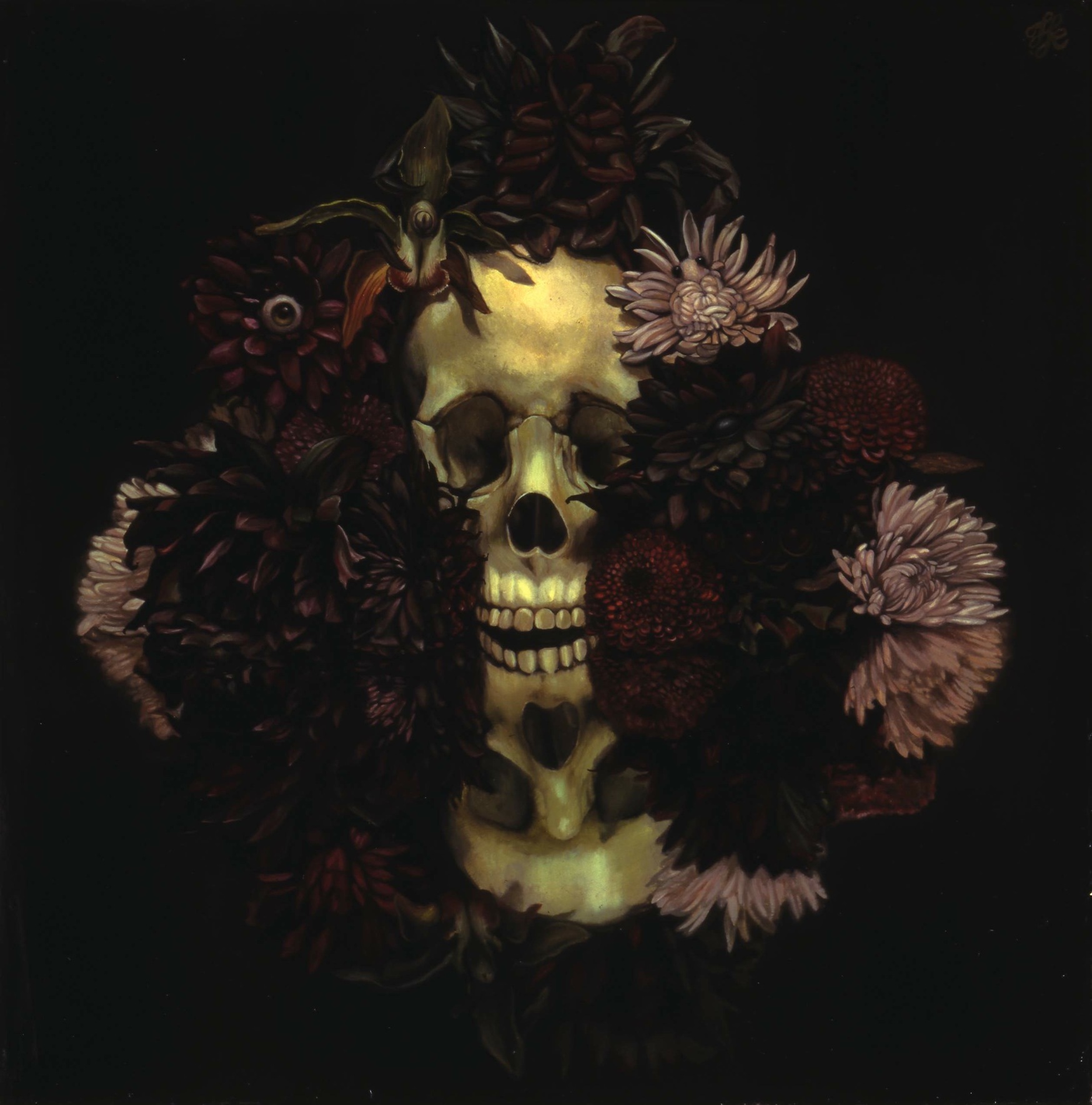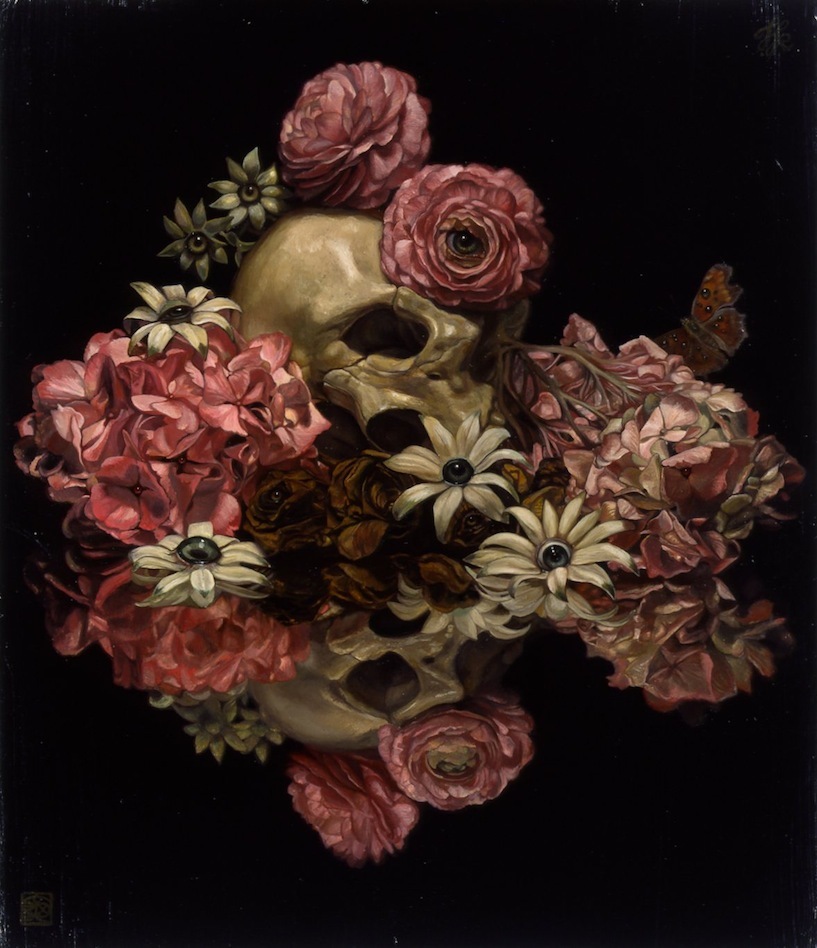Vanitas in Latin means “emptiness”. In art history, the word refers to a genre of still life paintings that employs the symbolic motifs of skulls and rotting fruit to evoke the duality of life and death. The Japanese artist Toru Kamei has, for the last ten years, been striving to breathe new life into this 16th century European style with his own bewitching and beautiful work where surreal subjects seem to float on jet-black backdrops. His paintings have a sense of solemn profundity, but Toru himself claims he merely paints objects “as they are.” Recently, Dior Homme’s creative director Kris Van Assche contacted the artist with an invite to collaborate, resulting in Toru’s gothic imagery being featured in the spring/summer 17 collection. Yet, despite the increased attention he has received as a result, the artist continues to work away at his own steady pace. It’s as if his acceptance of the inevitability of death has turned him into a living reminder of the futility of hurrying through life.
When did you decide you wanted to be an artist?
I’ve wanted to be a painter since I was little. I didn’t know if it was something I could get into as a practical profession, but I always knew I wanted to make paintings. I knew that if I was going to go to university, I wanted to study art. But, it was only once I’d graduated from university that I was forced to decide if I was going to really work at becoming an artist or not. Most of the really excellent artists get invited to show their work at galleries before they even graduate, but in my case I never did. I was kind of at a loss. That’s when I first really decided that I absolutely wanted to become an artist and it was around that time that I painted this mural [a floral painting, with a strong Southeast Asian feel, on the walls of Bistro Ami in Meguro, Tokyo — where this interview took place].

How do you decide when you’re finished with a piece? Do you work at home? And what does an average day look like for you?
If I have a deadline, that’s sometimes when I end up finishing. But usually I just get a sense when a painting is finished. It’s intuition, I guess. My studio is right next to where I sleep at night, so I spend my days painting, eating, going online, and stuff. Sometimes I’ll turn back to a painting halfway through a meal. I’m free to do what I want, more or less. Sure, I have deadlines, but I’m the one who sets them. Right now, I decide everything for myself.
Do you ever get stuck in a rut?
Yes, absolutely. I sometimes get periods where I can’t paint, and, at times, my work doesn’t sell, either.
Do those periods last long? What do you do then?
I’ve had stretches of two to three years at a time when I couldn’t really paint or sell my art. Freelance artists like me usually don’t have a steady income, and I have to work to support myself, but I’m steadily plugging away at it for now. I’m pretty resolute, you know? Selling paintings isn’t the only objective for an artist and a painting can still be great even if it doesn’t sell. That’s something I’ve come to realize.
A number of your paintings are featured in the Dior Homme spring/summer 17 collection that was announced last year. How did that come about?
Someone from Dior Homme got in touch with me first of all. He put me in contact with their people in Paris and I started hashing things out with the creative team over there. I don’t know how Kris Van Assche came across my work, but in his official statement he said that he discovered me while doing researching floral motifs.

Are there any motifs that you’ve been particularly into lately?
My paintings are figurative — that is to say, I start off by depicting real objects. I don’t mean to abandon that entirely, but recently I’ve been gradually trying to distance myself from that figurative side of things. When you listen to music, it feels like the sound works its way into your soul. Sound is made of waves, right? Color and light are made of waves too, so I think they affect our spirits in the same way. When I paint something figurative, the people who see that painting get caught up on its meaning. That’s not a bad thing, but I want to try to make art that speaks directly to the senses on a more natural level, without being so restricted by “meaning.”
That sounds like it could allow you to express your inner self a little more freely. In closing, is there anything you’d like to say to anyone reading this article who has their sights set on becoming an artist?
I believe that, as an artist, if you don’t want to lose your creativity and passion you need to always stay true to yourself and keep doing the things you want to do most. If you’re selling your art in the commercial sector, you really need to know what rights you’ll retain over your work — so you need to choose your agents carefully. The best thing is if a gallery can support you as an artist for a long time.

Credits
Text Daiho Tateishi
